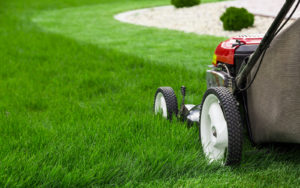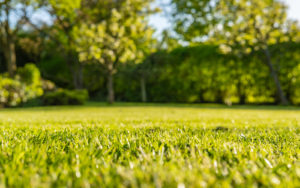Have you always wanted to have a lush, well-cared for, and pristine lawn? Maintaining top-quality grass seems like an unachievable task for many homeowners. Lawn mowing and ongoing, regular maintenance is essential for the safety and cleanliness of your property. Overgrown lawns can turn into a terrible nuisance that poses safety risks, especially to children. Keeping your yard healthy and green year-round requires regular attention as well as knowledge of lawn mowing techniques.
Frustrated by your lawn? Let the pros at Rivas Landscaping lighten your load. Contact us today!
Homeowners often find it challenging to stay on top of an effective lawn care routine. If you dream of a finely manicured and attractive lawn, you’ll want to follow some professional lawn mowing and yard care maintenance advice to achieve this. These pro lawn maintenance tips will give you results that will leave your neighbors wondering how you accomplished it.
1. Fixing Lawn Spots.
Does your lawn suffer from dog spots, thatch, fairy rings, grubs, and overly shaded grass? Dog spots are round patches caused by dog urine, which contains high concentrations of acids, salts, and nitrogen. These elements scorch and kill grass’s roots. To avoid drying out the roots, ensure that your pet’s favorite areas in your lawn get soaked with water to get the salt out of the roots before the grass dries out.
Do you find areas in your lawn where the grass feels soft and spongy? This may indicate that your lawn is suffering from thatch. Thach comes from dead stalks and roots that settle between the grass’s green shoots and the soil. If your yard is prone to thatch, reduce the use of fertilizers and pesticides, and aerate the yard at least once a week. You can also hire a professional to perform lawn aeration.
Fungi is the cause of what’s often called “fairy rings.” The decomposition of organic matter releases nitrogen and obstructs the water flow to turf roots, which then develops thin, dead spots. Manually aerating the ring will break up the fungus and allow water to flow to the grass’s roots.
Are you seeing patchy areas? Lawn grubs may be the cause. Lawn grubs are the larval stage of moths and beetles, and they thrive in shady grass. Spots affected by grubs will appear thin and patchy. By trimming back trees and shrubs and increasing sunlight to the shaded areas, you can reduce the impact of lawn grubs.
2. Keep your lawn healthier, greener, and thicker.
How do you grow greener grass? The first step is to make sure the grass is kept sufficiently moist. Your lawn should be watered deeply enough to penetrate the soil about 5 to 6 inches. Water your yard, then plunge a spade into the ground and pry out a wedge to see how far the water has penetrated. Do this test a few times after watering and you will get an idea of how long and how often it should be watered to get sufficient moisture penetration.
You may need to adjust your watering depending on your soil type and weather conditions. Heavy soils will not need to be watered as often or as much, but benefit from a lighter watering for a longer time. Sandy soil should be watered frequently, heavy and fast, as they dry out more quickly. During hot weather you may need to water every day.
Remember to keep up with fertilizing and tracking your lawn’s pH level. Fertilization should be done in the fall to help the roots soak up nutrients and store energy for the upcoming growing season. Grass thrives in a pH environment between 6 and 7.2. If the pH level is high, you can treat your lawn with iron sulfate or sulfur. If the pH level is low, you can use pelletized limestone to improve it. Broadcast spreaders spew out the granules randomly for more consistent coverage.
For best results, attack broadleaf weeds during mild weather, and be sure to kill crabgrass before it spreads to the rest of the grass. If you have only a few weeds, you can eliminate them by pulling by hand or spray each one using a pump-up sprayer. Use concentrates with water to reduce the potency of chemicals, being sure to carefully follow the package directions.
3. Harness the power of mulch.
You can reduce the time you have to spend weeding by using organic mulch or landscape fabric. Black plastic is not advised for most lawn care purposes as it does not allow rain to reach plant roots. Instead, it traps moisture, encouraging the growth of mold and mildew. An organic mulch decomposes over time, adds organic matter to the soil, and nourishes your plants and trees. Landscape fabric decomposes more slowly than mulch when protected from sunlight. Ensure the pores in the fabric are small enough to prevent weeds from growing through the barrier. It should also be strong enough that you cannot tear or stretch it easily.
The benefits of mulching extend far beyond weed suppression. Using mulch enhances your soil quality, reduces moisture evaporation, and protects plant roots from temperature swings. It also increases your home’s curb appeal. Mulch adds color and texture to your overall garden design. Wood chip mulch comes in a variety of colors to complement any yard style. Use aged organic mulch for improving soil quality and plant growth. Mulch installation may be the fastest and least expensive yard improvement technique there is.
4. Use a landscape edger.
Edging gives your yard the definition of crisp, clean border lines that cannot be achieved through lawn mowing alone. Edgers are typically used along the street curb, around garden beds, and next to driveways and sidewalks. If you have a larger lawn with lots of places that need to be edged, you’ll want to buy a bigger, gas-powered edger. If your property is smaller or has only a few areas that require edging, a smaller electric unit may be good enough. Keep in mind that electric edgers usually only have a 100-foot radius from an outlet, so if you need to go further than that you’ll want a gas-powered edger.
5. Cut and water like a pro.
Set your cutting height to one and a half inches for your first lawn mowing pass to eliminate dead grass and let more sunlight reach the grass crowns. Raise the blade by two inches during hot weather to protect the grass and roots from drying out in the heat. For cold season lawn mowing, lower the blade height by half an inch. After mowing, think twice about raking up the clippings. Leaving the clippings helps with water conservation and returns nutrients to the soil as it decomposes. You will also want to use fertilizers and weed killers at appropriate times to ensure adequate sunlight for seed germination and root development.
Lawn mowing with a dull blade will never give you a professional looking cut. Make sure your mower blade is sharp and clean. For best results, sharpen and balance the blade three times a year to maintain a precise cutting edge.
Damaged grass turns yellow, needs more water and nutrients, and is more vulnerable to diseases. Keep up on your watering to prevent this from happening to your lawn. Most lawns require one to two inches of water three or four days per week to develop deep roots. Therefore, fewer good soakings are better than many light sprinklings. Light sprinklings only moisten the very surface of the soil, promoting shallow root growth. This leads to fragile, weak rooted grass that needs more frequent watering.
6. Control erosion on slopes.
If you’ve got a sloping area in your yard experiencing a lot of erosion, consider adding a dry creek bed. This feature can help you control erosion by re-routing the flow of rain. A dry creek bed directs the flow of water to a sandy area to prevent erosion. Using rocks of various sizes to create the creek bed improves its water-carrying capabilities. It’s an attractive hardscape feature as well as being functional.
To control erosion on a steep slope, terrace the hill with stone retaining walls to flatten the inclination and gradually slow drainage. Avoid using plastic, mulch, or straw grass covers alone to reduce erosion on the slope. They won’t be effective for very long and will wash away quickly.
7. Keep shaded areas attractive with a shade garden.
You love your beautiful, mature trees and the cooling shade they bring, but your grass doesn’t. If heavy shade has made growing grass in parts of your lawn a challenge, consider creating a shade garden. You’ll want to research which drought and shade tolerant plants thrive in your area. Once you have your plants, add additional soil to the site. Take care not to cover existing tree roots with more than one inch of soil, and keep your new plants at least a foot away from the tree trunk.
Species like oak, lindens or magnolias are trees with shallow roots. If these trees are causing excessive shade, you may want to use planters for your shade garden instead of in-ground plants. This will help avoid the roots competing too heavily for soil nutrients. Always be sure to give your newly planted shade garden a good watering to help them take root.
If you’re not sure which plants are right for your shaded area, consider outsourcing your planting and garden maintenance to an expert.
8. Cure a boggy backyard.
If your backyard is at the bottom of the slope, heavy rain can often turn that space into a muddy mess. It’s not only unsightly, it can quickly become a breeding ground for pests like mosquitoes. You can resolve this problem by adding a drainage pipe enclosed in a gravel-filled trench. Water flows significantly faster through rock than through dirt, and the pipe can direct the water to a place where it will do less damage to your lawn.
9. Avoid swampy spots with a rain garden.
Maybe your backyard is fine, but you’ve got areas in your lawn that become soggy after rainstorms. This is caused by low spots that fill with water from the rain. The excess moisture makes it difficult to keep the grass healthy, and the uneven terrain makes lawn mowing frustrating. Instead of fighting the swamp, use it to your advantage by building a rain garden.
In the area where your lawn tends to collect water and turn into a swamp, create a garden bed and fill it with deep-rooted plant species that thrive in your climate. This will help drain the water faster, feed those hungry plant roots, and enhance the beauty of your yard. Keep your rain garden at least 10 feet from your foundation so you don’t end up with seepage problems in your basement.
The Perfect Lawn Takes Time and Effort
As you can see, a lot of skill, planning, and hard work goes into creating the lush, green, pristine lawn everyone wants. This is why many homeowners outsource lawn mowing and the rest of their yard work to seasoned pros who know what they’re doing. If you’re struggling with your lawn, it may be time to hand this work over to the experts. Contact Rivas Landscaping today and find out what professional lawn care can do for your curb appeal.



